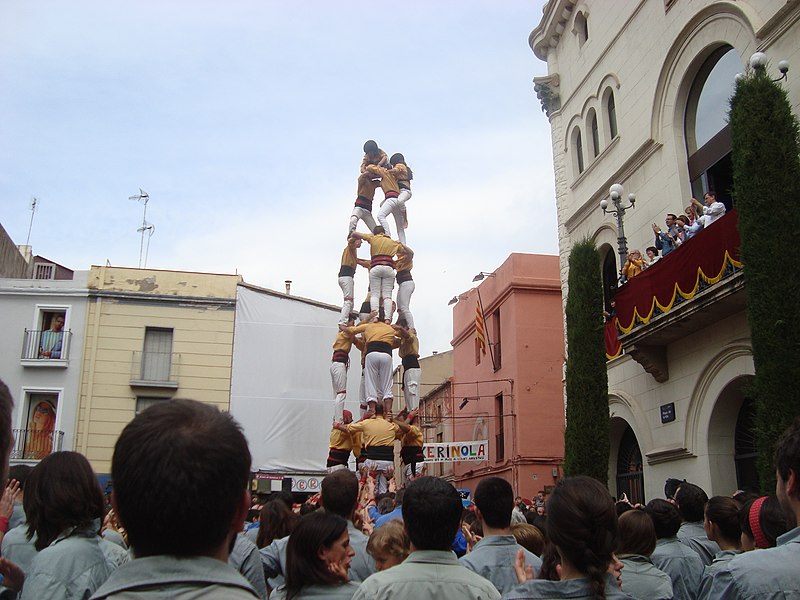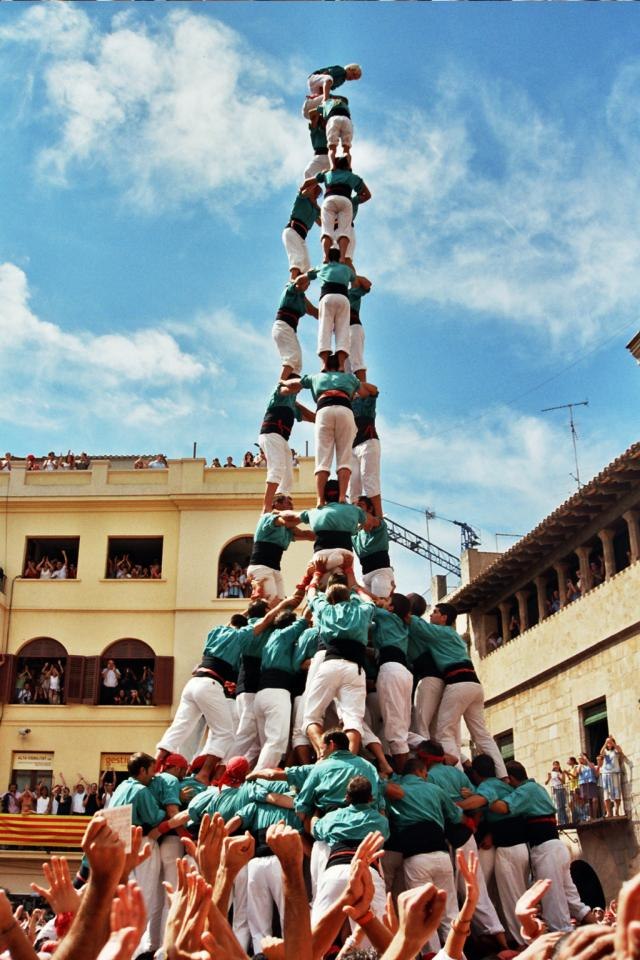
🏗️ Castellers: The Spectacular Human Towers of Catalonia
The Castellers are one of Catalonia’s most impressive and unique traditions. These human towers, formed by people standing on each other’s shoulders, are an incredible display of strength, balance, teamwork, and courage.
Seeing a castell (the Catalan word for «castle») being built is an unforgettable experience. The crowd holds its breath as the tower rises, layer by layer, until a small child reaches the top and raises their hand. It’s a tradition that combines sport, culture, and community spirit, and it has been recognized as Intangible Cultural Heritage of Humanity by UNESCO.
📜 Origins: Where Did Castellers Come From?
The tradition of building human towers began in the 18th century in the town of Valls, near Tarragona. Originally, it was part of a local dance called the Ball de Valencians, where participants would form small human structures at the end of the dance. Over time, these formations became more complex, evolving into a competition to build the tallest and most stable towers.
By the 19th century, the first official Colles Castelleres (Casteller teams) were formed, and the tradition spread across Catalonia, becoming a symbol of Catalan identity and resilience.
🏰 How Are Human Towers Built?
Building a human tower requires perfect coordination, trust, and physical endurance. Each casteller has a specific role depending on their strength, weight, and experience:
- Pinya (Base): This is the foundation of the tower, formed by a large group of people who provide stability and absorb the weight of the structure. They act as a safety net in case of a fall.
- Tronc (Main Structure): The middle levels of the tower, made up of castellers standing on each other’s shoulders in one, two, or even three-person layers.
- Pom de dalt (Top Levels): The lightest and most agile participants, usually children, climb the final levels.
- Enxaneta (Final Climber): The child who reaches the very top of the tower and raises their hand, officially completing the castell.
Once the tower is built, the castellers must carefully climb down, maintaining balance until the structure is fully dismantled.
🏅 Safety Measures
Although Castellers rely mostly on strength and balance, there are some important safety measures in place:
- Faixa (Black Sash): A wide sash wrapped tightly around the waist to support the lower back and provide a grip for climbers.
- Helmets for Enxanetes: Since 2006, children who climb to the top must wear a protective helmet designed to absorb impact in case of a fall. These helmets are often decorated in the colors of their team.
🎉 Where to See Castellers
The best way to experience this tradition is to attend a Casteller performance, where different teams compete to build the tallest and most complex towers.
Some of the most important events include:
- La Mercè Festival (Barcelona – September): One of the most famous Casteller events, held in Plaça de Sant Jaume.
- Santa Tecla Festival (Tarragona – September): A historic Casteller gathering in one of Catalonia’s Casteller capitals.
- Concurs de Castells (Tarragona – Every two years): The biggest human tower competition in the world, where teams from all over Catalonia compete to build the highest and most difficult structures.
- Sant Fèlix Festival (Vilafranca del Penedès – August 30th): A prestigious event where the best Colles Castelleres showcase their skills.
📆 Here you can find a calendar of Casteller performances in Catalonia.
🤯 Fun Facts & Records
✔️ The tallest castell ever built was a 10-level tower by the Colla Vella dels Xiquets de Valls and the Colla Joves Xiquets de Valls. Only a few teams in history have achieved this feat!
✔️ The highest fall ever recorded happened in 1993, when a nine-level castell collapsed in Vilafranca del Penedès. Fortunately, the strong pinya prevented any serious injuries.
✔️ Women play a huge role in Castellers! In the past, it was mostly men who participated, but today, women and children are an essential part of the teams, especially in the lighter top levels.
✔️ Being a casteller is for all ages! Some teams have members as young as 5 years old (for the top levels) and others in their 70s or 80s in the base.
✔️ The Casteller motto is: «Força, equilibri, valor i seny» (Strength, balance, courage, and wisdom).
💪 More Than Just a Show: A Symbol of Catalonia
Castellers are more than just a performance—they are a representation of Catalan culture and identity. The tradition symbolizes:
- Unity and teamwork
- Perseverance and resilience
- The strength of the Catalan people
This is why Castellers have become a cultural emblem of Catalonia, appearing at political events, festivals, and even international celebrations.
🔹 Tip: If you ever attend a Casteller event, remember to stay silent when the tower is being built—it’s a moment of extreme concentration!
Would you dare to climb a human tower? 🤔🏗️wer? 🤔🏗️
